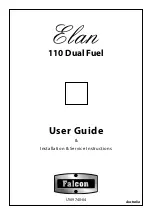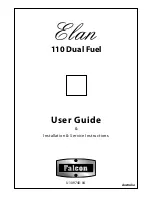
20
INSTaLLaTION
The appliance must be installed by qualified staff working in accord-
ance with the regulations in force.Before installing, ensure that the
appliance is correctly preset for the local distribution conditions (gas
type and pressure).The presettings of this appliance are indicated on
the nameplate shown on the cover.This appliance is not connected
to a flue gas extractor device. It must be installed and connected in
accordance with the regulations in force.This appliance may only
be installed and may only operate in rooms permanently ventilated
in accordance with national regulations in force.
VENTILaTION
The rooms in which gas appliances are installed must be well ven-
tilated in order to allow correct gas combustion and ventilation.
The air flow necessary for combustion is at least 2 m
3
/h for each
kW of rated power.
POSITIONING
Remove the packaging accessories, including the films covering the
chrome-plated and stainless steel parts, from the cooker.
Position the cooker in a dry, convenient and draft-free place. Keep
at an appropriate distance from walls which may be damaged by
heat (wood, linoleum, paper, etc.).
The cooker may be free-standing (class 1) or between two units (in
class 2 st 2-1) the sides of which must withstand a temperature of
100°C and which must not be higher than the working table.
FITTING ThE FEET (LEVELLING)
Cookers are equipped with adjustable feet to be screwed into their
front and rear corners respectively. The feet allow the height of the
appliance to be adjusted, in order to set it flush with the adjoining
unit, to level it with other worktops and to ensure even distribution
of the liquids in pans. See fig. 3.
BaLaNcING ThE LID (present only in a few models)
Models equipped with plate glass lids are fitted with special ba-
lanced springs. These are fitted into the hinge to provide smooth,
gentle lid closure.
GaS cYLINDER cONNEcTION
Make the connection to the butane-propane cylinder using an
approved hose from 75 to 80 cm long, following the route shown
in figure 4.
The hose must not touch the side near the oven. The maximum
gas cylinder size is diameter 31 cm and height 60 cm, with capacity
from 10 to 13 kg.
cONNEcTING TO ThE GaS SUPPLY
Before connecting the cooker, check that it is preset for the gas
to be used. Otherwise, make the conversion as described in the
section headed “Adapting to different gas types”. The connection
is on the right; if the pipe has to pass behind the cooker, it must be
kept low down where the temperature is about 50 degrees C.
- Rigid connection (see Figure 5, diagram D):
The connection to the mains gas supply may be made using a
rigid metal pipe (D). Remove the hose connector and screw the
rigid union onto the threaded connection of the gas train. The
union for rigid connection is amongst the cooker accessories.
- Connection using a rubber hose (see Figure 5, diagrams B and
C):
Connect a rubber hose carrying the conformity mark currently in
force to the hose connector. The hose must be replaced at the
date indicated, and must be secured at both ends using standard
hose clamps. It must be absolutely accessible to allow its condition
to be checked along its entire length.
- Connection using a metal hose (see Figure 5, diagram D):
Make the connection using a hose which complies with national
standards, screwing it onto the connector with a ring seal, which
is delivered amongst the cooker accessories.
- After installation, check that all connections are airtight.
- For operation with butane/propane, check that the gas pressure
is as indicated on the nameplate.
IMPORTaNT:
- Use only standard rubber hoses. For LPG, use a hose which
complies with the national regulations in force.
- Avoid sharp bends in the pipe and keep it well away from hot
surfaces.
Installation
GB
*
At 15°C and 1013 mbar-dry gas
**
Propane
P.C.S. = 50,37 MJ/Kg G 31
***
Butane
P.C.S. = 49,47 MJ/Kg G 30
Natural
P.C.S. = 37,78 MJ/
m
3
G 20
City P.C.S. = 15,87 MJ/
m
3
G 110
Table 1
Liquid gas G30-G31
Natural gas G20
Burner
Diameter
(mm)
Thermal power
kw(p.c.s.*)
By-pass
1/100
Nozzle
1/100
Flow *
g/h
Nozzle
1/100
Flow
l/h
Nomin.
Ridot.
(mm)
(mm)
***
**
(mm)
Rapid
(Big)R
110
2.80
0.80
45
83
204
200
123
267
Semi Fast
(Medium) S
86
1.65
0.58
35
65
120
118
97
157
Auxiliary
(Small) A
66
1.00
0.40
32
50
73
71
77
95
Triple Ring (TC)
Economic
145
4.00
1.50
70
98
291
286
145
381
Oven (Thermostat)
-
3.00
1.00
47
86
218
214
130
286
Oven (Tap)
-
3.00
1.30
52
86
218
214
130
286
Grill
-
2.00
-
-
70
145
143
110
191
Supply
pressures
Nominal (mbar)
Minimum (mbar)
Maximum (mbar)
28-30
20
35
20
17
25
















































